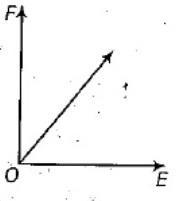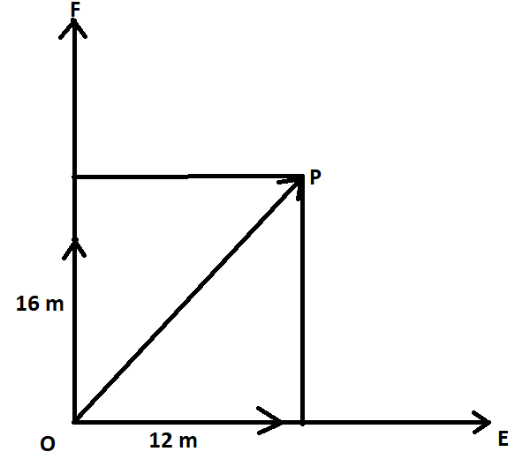Question
Question: A body of mass \(2\;kg\) has an initial velocity of \(3\;m{s^{ - 1}}\) along \(OE\) and it is subjec...
A body of mass 2kg has an initial velocity of 3ms−1 along OE and it is subjected to a force of 4N along of direction perpendicular to OE as shown in figure. What is the distance travelled by the body in 4s from O?

A. 12m
B. 20m
C. 28m
D. 48m
Solution
Hint: Initially, the body of mass 2kg has a constant velocity in the direction OE, by using the distance and speed relation the distance travelled by the body in the direction OE can be calculated. Then a force is applied on the body along the direction OF. Thus, the force generates an acceleration on the body along the direction OF and by using Newton's law of motion, the acceleration value is derived. And by applying the equation of motion, the distance travelled in the direction OF can be calculated. Finally, using Pythagoras theorem to calculate the distance travelled by body after 4s.
Useful formula:
Relation between velocity and displacement,
Displacement = Velocity * Time
Equation of motion is given by,
S=ut+21at2
Where, S is the displacement, u is the initial velocity, t is the time taken and a is the acceleration of the body.
Newton’s second law of motion is given by,
F=ma
Where, F is the force applied on the body, m is the mass of the body and a is the acceleration of the body.
Given data:
Mass of the body, m=2kg
Initial velocity of body along OE, VOE=3ms−1
Force applied along OF, F=4N
Time taken by the body, t=4s
Complete Step by step solution:
The distance travelled by the body along OE,
SOE=VOE×t
Where, SOE is the displacement along OE.
Substituting the given values in above equation,
SOE=3ms−1×4s SOE=12m
The acceleration of the body along OF by Newton’s law,
a=mF
Substituting the given values in above equation,
a=2kg4N a=2ms−2
By applying equation of motion along direction OF,
SOF=ut+21at2
Where, SOF is the displacement along OF.
Substituting the given values in above equation, we get
SOF=(0×4)+21(2ms−2×(4s)2) SOF=21(2×16) SOF=16m
Hence, the free body diagram should be,

By applying Pythagoras theorem, we get
(OP)2=(12)2+(16)2 OP=(144+256) OP=400 OP=20m
Hence, the option (B) is correct.
Note: A body of certain mass, moving in the linear direction and then an additional force is applied on that body tends the body to move in the resultant direction of the force. Thus, the body moves along OP, due to the force on the two normal sides of the body.
